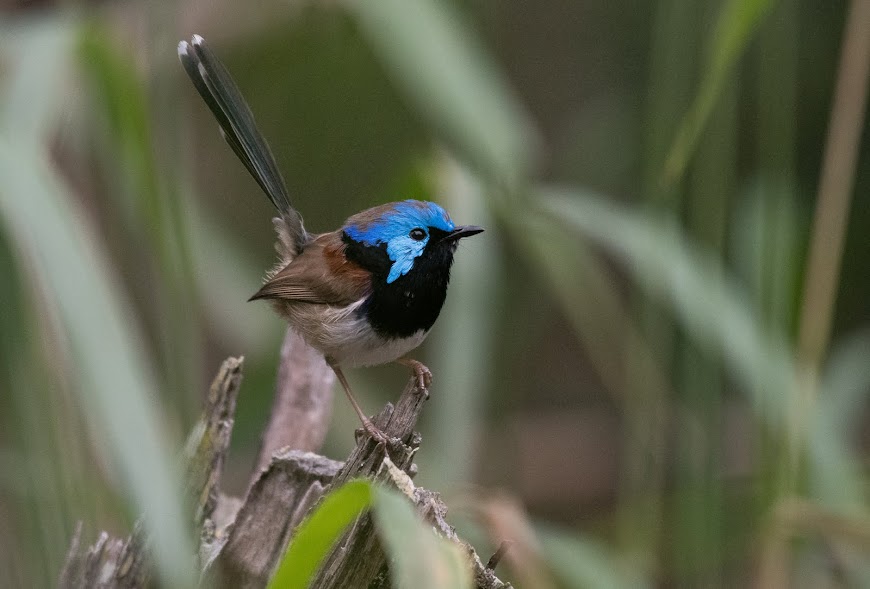Galahs enjoying the early morning sunshine.
Acacia fimbriata also known as Fringed Wattle or Brisbane Golden Wattle, is blooming profusely along the creek and in the woodland, spreading its delicate smell across the reserve.
The Noisy Friarbird can now be heard and seen more regularly.
Grey Fantail
A female Rose Robin, only a few weeks left before they will move out from the reserve to reach their breeding grounds.
I've been surprised to see Koalas quite regularly this winter, here is another one sleeping not far from the track right in the middle of the reserve.
Sulphur-crested Cockatoo.
A Laughing Kookaburra.
Australian Wood Ducks, male above and female below.
Azure Kingfisher while fishing along Enoggera Creek.
MID AUGUST
A Scaly-breasted Lorikeet feeding on Gumtree flowers.
A Crested Pigeon calling for a mate, seconds later it took off for a flight display.
White-faced Heron fishing.
Some Koala interaction happened just above one of the main tracks, where a bigger koala, possibly the male, according to a local, tried to approach the female, smaller and not doing much but just hanging from a branch. When I arrived, the bigger koala then move up on the branch smelling some leaves. Koala breeding season goes approximately from August to February.
MID AUGUST
A Scaly-breasted Lorikeet feeding on Gumtree flowers.
A Crested Pigeon calling for a mate, seconds later it took off for a flight display.
White-faced Heron fishing.
Some Koala interaction happened just above one of the main tracks, where a bigger koala, possibly the male, according to a local, tried to approach the female, smaller and not doing much but just hanging from a branch. When I arrived, the bigger koala then move up on the branch smelling some leaves. Koala breeding season goes approximately from August to February.
Variegated Fairywren parties are out and about in the undergrowth, some of their thin calls sound like young birds begging for food, although they could also be the White-browed Scrubwrens which are often with or near the Variegated Fairywrens, I still haven't had a chance to find out or to confirm young birds for either species.
Rainbow Lorikeets, like Galahs, like to check out the hollows of this tree but no birds seem to ever manage to nest inside. Noisy Miners and Blue-faced Honeyeaters are often quite alarmed pointing at the hollows suggesting something, not necessarily dangerous, is inside.
Two days after the Full Moon, a beautiful Waining Gibbous moon was setting on the western sky as I arrived at the car park on 17.8.
A pair of Pacific Black Ducks feeding in the creek, where the water lever is dropping every day more.
The first Spectacled Monarch of the season arrived on 17.8.
Superb Fairywrens haven't been seen at Bank's Street Reserve for a long time (last eBird record is from 1992). The area I saw this single bird, is where controlled burning happened last year, I'm not sure if there is a connection. I had seen some shy and 'suspicious' Fairywrens there a few days back but could not identify them, in a small corner of tall grass that is not usually frequented by the other Fairywrens of the reserve, the Red-backed and the Variegated.
A female Magpie-lark.
A snake's skin on the cycling path.
Meadow Argus - Junonia villida.
I could not identify this small species of butterfly belonging to the Lycaenidae family.
LATE AUGUST
A large flock of about forty Silvereyes visited the reserve in late August, the flock included many birds from the subspecies lateralis heading back to Tasmania to breed. They can be distinguished from by the rusty colour on the feathers of their flanks.
Yellow-faced Honeyater
I was very surprised to see a White-winged Triller, also another migrant, in the reserve on 24.8, the last record was from the 90's!
Torresian Crow.
The resident Flying Fox colony.
An immature female Fantailed Cuckoo.
Australian White Ibis
It's nice to see that the Brisbane City Council is making an effort to let the visiting people know about the local and vulnerable wildlife. Much of the habitat at Banks Street Reserve has been restored by hard working volunteers for many years, if today we and wildlife can enjoy this beautiful place is thanks to the hard work of the Habitat Brisbane programs and volunteers. Volunteering opportunities are regularly advertised on the Habitat Brisbane blackboard near the creek crossing.
Meadow Argus - Junonia villida
I was very glad to be able to photograph a pair of Striated Pardalotes that descended from the high canopy, where they usually are found in the reserve.
This is a female Grey Butcherbird, the large white patch between the bill and the eye is much smaller in males.
Immature Pale-headed Rosella

Spectacled Monarchs can be found in the thickest parts of the reserve, calling and feeding during their spring migration.
Brush Turkeys, male and female on the nest, the male showed some territorial behaviour towards a female-looking bird, chasing it away, not sure if a female or young male? He was very accepting of the other female which was allowed to access the nest and dig in the hole.
An immature male King Parrot.
A tail feather of a Tawny Frogmouth, very hard to find them during the day.
I don't think this very wild fight between these two Kookaburras ended well for the one on the right side. The bird on the left was holding it down by the neck suffocating it.
A male Figbird feeding on berries.
During August, I visited Banks Street Reserve ten times, I saw a total of 66 species of birds, on average 46.5 per outing. I am looking forward to see what the migration month of September will bring to the reserve. Here is the list of all the birds seen in August.

















































